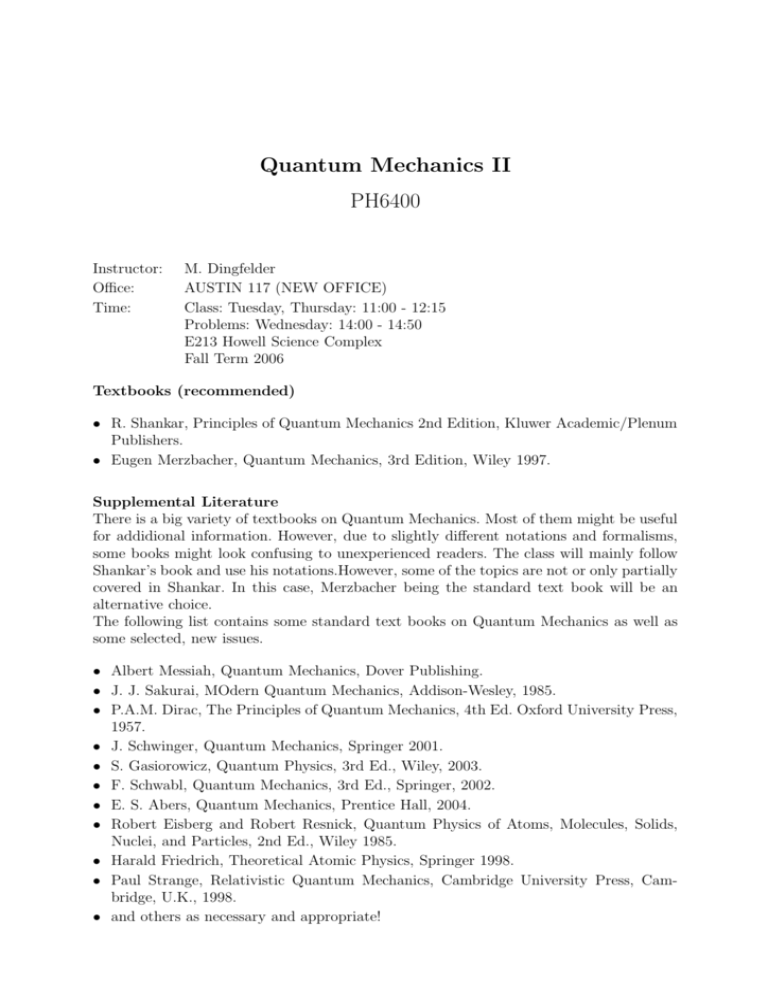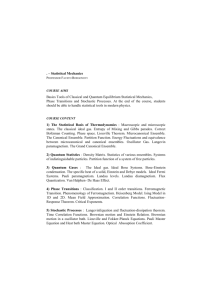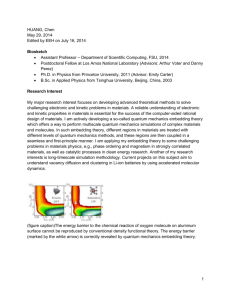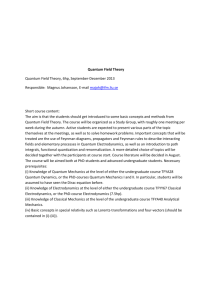Quantum Mechanics II PH6400
advertisement

Quantum Mechanics II PH6400 Instructor: Office: Time: M. Dingfelder AUSTIN 117 (NEW OFFICE) Class: Tuesday, Thursday: 11:00 - 12:15 Problems: Wednesday: 14:00 - 14:50 E213 Howell Science Complex Fall Term 2006 Textbooks (recommended) • R. Shankar, Principles of Quantum Mechanics 2nd Edition, Kluwer Academic/Plenum Publishers. • Eugen Merzbacher, Quantum Mechanics, 3rd Edition, Wiley 1997. Supplemental Literature There is a big variety of textbooks on Quantum Mechanics. Most of them might be useful for addidional information. However, due to slightly different notations and formalisms, some books might look confusing to unexperienced readers. The class will mainly follow Shankar’s book and use his notations.However, some of the topics are not or only partially covered in Shankar. In this case, Merzbacher being the standard text book will be an alternative choice. The following list contains some standard text books on Quantum Mechanics as well as some selected, new issues. • Albert Messiah, Quantum Mechanics, Dover Publishing. • J. J. Sakurai, MOdern Quantum Mechanics, Addison-Wesley, 1985. • P.A.M. Dirac, The Principles of Quantum Mechanics, 4th Ed. Oxford University Press, 1957. • J. Schwinger, Quantum Mechanics, Springer 2001. • S. Gasiorowicz, Quantum Physics, 3rd Ed., Wiley, 2003. • F. Schwabl, Quantum Mechanics, 3rd Ed., Springer, 2002. • E. S. Abers, Quantum Mechanics, Prentice Hall, 2004. • Robert Eisberg and Robert Resnick, Quantum Physics of Atoms, Molecules, Solids, Nuclei, and Particles, 2nd Ed., Wiley 1985. • Harald Friedrich, Theoretical Atomic Physics, Springer 1998. • Paul Strange, Relativistic Quantum Mechanics, Cambridge University Press, Cambridge, U.K., 1998. • and others as necessary and appropriate! Contents and Schedule • CONTENTS AND SCHEDULE IS APPROXIMATE! • Dates for material to be covered can change on a day-by-day basis to conform to student interest and class dynamics. 1. 2. 3. 4. 5. 6. Summary of Phys 5400: Quantum Mechanics I • Postulates • Schrödinger Equation • Angular Momentum I • Hydrogen Atom Theory of Angular Momentum II • Spin • Addition of Angular Momenta • Clebsh-Gordan Series • Tensor Operators and the Wigner-Eckhart theorem Approximation Methods • Variational Methods • Time Independent Perturbation Theory • Time Dependent Perturbation Theory Second Quantization and Many-Body Systems • Second Quantization • Hartree-Fock Method • Quantization of the Electromagnetic Field Scattering Theories • Cross Sections and Green’s Functions • Born Approximation • Partial Waves and Phase Shifts • Formal Theory of Scattering Relativistic Electron Theory • The Dirac Equation • Covariant Formalism • The Free Field Solution Important dates: Oct 3: Nov 7: tba: Test I Test II Finals (scheduled: Dec 15). Sep 4: Oct 16-17: Oct 18: Nov 22-25: no classes (Labor Day) Fall break. Monday schedule Thanksgiving break Course Scoring Scoring will be divided into three categories: 1. Homework. Homework will count 25% of the course grade. Each week a sheet with problems will be issued and has to be returned a week later (except in weeks with interim tests). Tentatively there will be 10 sheets with an ideal score of 10 points each. 2. Interim tests. There will be two tests during the semester. Each test will be weighted to count 20 % of the course grade, thus the two tests will contribute a total of 40 % of the course grade. 3. Final Exam. The final exam will count 35 % of the course grade. Each test, the final exam and all homework sheets together will be designed to yield 100 points for a perfect score. News and supplemental information News and additional course information (like the homework sheets and sometimes solutions) will be posted on the web page core.ecu.edu/phys/dingfelderm. Please check the web page from time to time. Office Hours I encourage everybody to stop by my office whenever you have questions or problems. Don’t hesitate to do so also outside official office hours.








